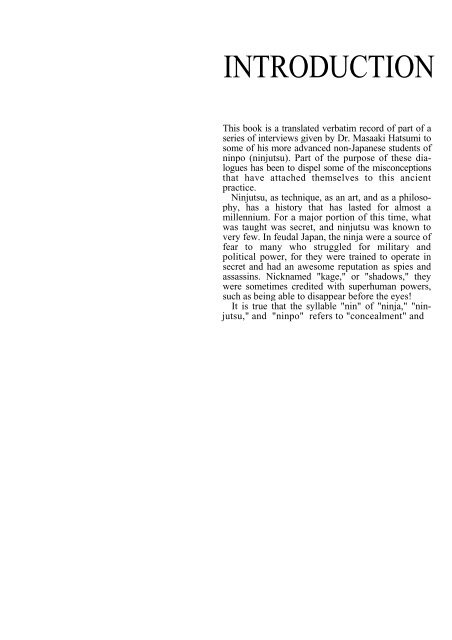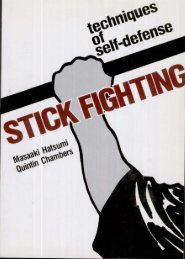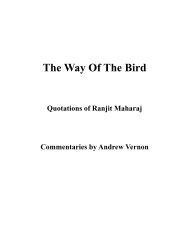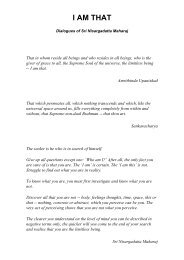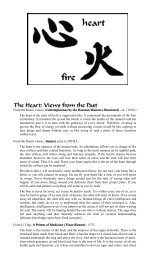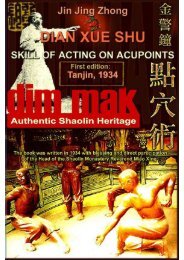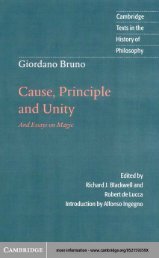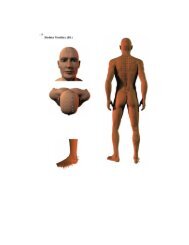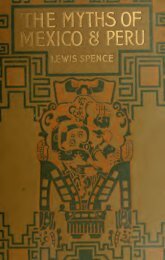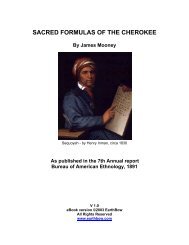You also want an ePaper? Increase the reach of your titles
YUMPU automatically turns print PDFs into web optimized ePapers that Google loves.
2 Dr. Masaaki Hatsumi<br />
"stealing in," but it also means "endurance," "fortitude,"<br />
and "forebearance."* In fact, historically, the<br />
ninja were highly-trained men and women (the latter<br />
sometimes called kunoichi) <strong>of</strong> unusual courage who<br />
had learned to make resourceful and ingenious use <strong>of</strong><br />
all aspects <strong>of</strong> their surroundings, as well as <strong>of</strong> practical<br />
psychology, to enable them to accomplish their<br />
<strong>of</strong>ten dangerous missions. <strong>The</strong>y were certainly not<br />
mere killers, as they are sometimes portrayed today.<br />
Numerous unique and cleverly designed devices,<br />
tools, and weapons that enabled the ninja to accomplish<br />
unusual feats still exist today.<br />
<strong>The</strong> ninja's ability to escape detection and survive<br />
by merging into a background and by being acutely<br />
responsive to changing circumstances is perhaps reflected<br />
in the survival <strong>of</strong> their art over ten centuries<br />
through adaptation to the times and fulfilling the<br />
needs <strong>of</strong> both its practitioners and <strong>of</strong> the society in<br />
which it lived—and still lives. For there have always<br />
been those who have valued alertness and awareness<br />
over the following <strong>of</strong> rules and the accumulation <strong>of</strong><br />
memorized "facts," have treasured sensitivity over<br />
form and formality, have prized living for the moment<br />
over spending a lifetime dying.<br />
And the times are indeed a changing. This once<br />
secret and shadowly art has now achieved considerable<br />
popularity, and unfortunately, through misunderstanding<br />
and exploitation, a certain amount <strong>of</strong><br />
notoriety, in many countries <strong>of</strong> the world. But the<br />
living knowledge <strong>of</strong> the ninja is now freely available<br />
for anyone interested enough to look beneath the surface.<br />
<strong>The</strong> principal source <strong>of</strong> this fascinating teaching<br />
is Dr. Masaaki Hatsumi, the Soke, or grandmaster,<br />
<strong>of</strong> no less than nine ancient schools.<br />
<strong>The</strong> current world <strong>of</strong> martial arts is ailing. Modern<br />
* Ja = person; jutsu = art, technique; po = principle, way,<br />
doctrine.<br />
<strong>The</strong> <strong>Grandmaster's</strong> Book <strong>of</strong> <strong>Ninja</strong> Training 3<br />
"martial arts" have become firmly attached to considerations<br />
<strong>of</strong> strong and weak, and <strong>of</strong> competition. But<br />
in this fixation, the real spirit <strong>of</strong> budo cannot be<br />
found. Tigers and other wild animals are indeed<br />
strong fighters, at least from the viewpoint <strong>of</strong> violence,<br />
and yet these strong fighters have fallen victim<br />
to man, a comparatively weak creature. Why? Men,<br />
from the earliest times, realizing their own weakness<br />
against these powerful beasts, devised means <strong>of</strong> capturing<br />
and killing them. And what this meant for<br />
man was not merely a victory in some competition: it<br />
was what enabled mankind to survive. I have given<br />
these interviews in order to bring back some reality,<br />
meaning, and credibility to the martial arts, for what<br />
in general passes for martial arts today is a collection<br />
<strong>of</strong> rule-bound practices mainly intended as vehicles<br />
for competition. I am not trying to disparage them as<br />
sports, but from the point <strong>of</strong> view <strong>of</strong> true budo, which<br />
has to be concerned with real conflict, they are very<br />
limited indeed.<br />
<strong>The</strong> reasons why I choose Doron Navon, Jack Hoban,<br />
and Charles Daniel for the interviews in this<br />
<strong>book</strong> are these: they have correctly and sincerely<br />
pursued the true essence <strong>of</strong> budo, not only through<br />
ninjutsu, but also through other martial arts <strong>of</strong> Japan<br />
and <strong>of</strong> other countries. Also, for them, this pursuit<br />
takes precedence over the economic considerations<br />
that can become attached to budo—indeed, it is<br />
deeply rooted in their nature, and they are all fine<br />
representatives <strong>of</strong> the Bujinkan Ninjutsu dojo.<br />
<strong>The</strong> way to learn, to become a martial artist <strong>of</strong><br />
excellence, is not to go about judging a partner as<br />
strong or weak, good or poor, and not to pay any<br />
attention to rank and such trivialities, but simply to<br />
look and to perceive the characteristics <strong>of</strong> the other<br />
person, and to keep going in one's own practice. This<br />
is what leads to the real victory—this, and also the<br />
kindness and openness <strong>of</strong> heart to help others to dis-


